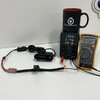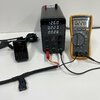@LateralNW is hitting on some very important issues.
I would like to offer an explanation why I suggested performing all future power consumption testing at 12.60 Volts, instead of 14.40 Volts (engine running).
Usually most consumers want to know the power consumption of a dash cam so they can calculate how long it will run in parking mode using a hardwire kit that has low voltage shut off connected to their vehicle battery, or dedicated dash cam battery pack. That means in this type of scenario the engine is off, and not running.
When I’m gathering power consumption data it would be more accurate to conduct two sets of tests.
One at 12.60 Volts (engine off).
One at 14.40 Volts (engine running).
However this would take a lot more time.
So in an effort to simplify our testing lives I suggested to
@rcg530 that we perform all power consumption testing at 12.60 Volts since that is the majority of consumer use, (parking mode engine off).
Back to the Nigel thing.
When I started testing dash cams here on DCT last year I was only publishing the Voltage & Amperage data for my measurements. Nigel made a very good point about also including the Wattage in the test data measurements because it makes it easier to interpret so a consumer can calculate how long a dash cam will run on a dash cam battery pack. Because it’s much easier to do the math with Watt Hours & Watts, instead of converting the Amperage measurements. Clear as mud? lol
-Chuck








